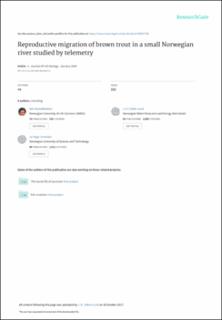| dc.description.abstract | The movement of 34 large (39–73 cm standard length) brown trout Salmo trutta was monitored using radio telemetry for up to 74 days in Brumunda, a small Norwegian river (mean annual discharge 3·3 m3 s−1) flowing into the large Lake Mjøsa. The maximum range of movement in the river was 20 km. No clear relationships existed between individual movement and water discharge, temperature and barometric pressure. Brown trout migrated at all levels of water discharge. At low discharge (3 s−1) movements were nocturnal. A weir 5·3 km from the outlet restricted ascending brown trout at low (c. 6° C), but not at high (c. 8° C) water temperatures. Spawning occurred in September to October and tagged individuals spent 2–51 days at the spawning sites. Mean migration speed from tagging to when the fish reached the spawning area, and from when they left the spawning areas and reached the lake was 1·0 and 2·3 km day−1, respectively. All tagged brown trout that survived spawning returned to the lake after spawning. | en_US |
